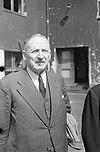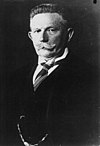Reich Ministry of Food and Agriculture
| Reichsministerium für Ernährung und Landwirtschaft | |
 | |
 The building of the Imperial Ministry of Food and Agriculture, at Wilhelmstrasse during the Nazi era. After the war was destroyed in the interior, the Palais was rebuilt in 1956 for reconstruction in 1960-62 by the . | |
| Agency overview | |
|---|---|
| Formed | March 1919 |
| Dissolved | 8 May 1945 |
| Jurisdiction | Nazi Germany |
| Minister responsible |
|
The Reich Ministry of Food and Agriculture (German: Reichsministerium für Ernährung und Landwirtschaft, abbreviated RMEL) was responsible for agricultural policy of Germany during the Weimar Republic from 1919 to 1933 and during the Third Reich from 1933 to 1945. It was under the office of the Secretary of State. On 1 January 1935, the ministry was merged with the , founded in 1879. In 1938 it was renamed "Reich and Prussian Ministry of Food and Agriculture". After the end of National Socialism in 1945 and the occupation, the Federal Ministry of Food and Agriculture was established in 1949 as a successor in the western Federal Republic of Germany.
History[]
In March 1919, the Reichsernährungsamt was the first to establish the "Reich Ministry of Food". This was combined with the Reich Ministry of Economics in September 1919 and re-founded during the Kapp Putsch in March 1920 under the name "Reich Ministry of Food and Agriculture". In the same year, the ministry moved into the at 72 Wilhelmstrasse in Berlin. From 1924, four large-format paintings by August Weber were on loan in the building, and since 1945 they have been lost.
After the Nazi's seized power on January 30, 1933, the ministry was initially led by Alfred Hugenberg. Coerced into resignation during June 1933, Hugenburg was succeeded by Kurt Schmitt and Walther Darré.[1] The latter took over on June 30, 1933 as "" the management of the Reich Ministry of Food and Agriculture,[2] where he was in this function also created for the Gleichschaltung of agriculture Reichsnährstand. The Nazi Darré, took personal leadership of the official party apparatus belonging to the Agricultural Policy Office (from 1936 "", and then from 1942 ""). The office was responsible for the management and supervision of the Reichsnährstandes.[3]
The RMEL, as it were, took over the state's supervision of the Reichsnährstand organization.[4] As a result, individual areas of responsibility were gradually transferred to other NS authorities. Thus, in 1934, by founding the Reich Ministry of Food and Agriculture, the Reich Forestry Office under the leadership of Hermann Göring was established as the highest Reich authority for forestry and hunting, timber management, nature conservation and nature conservation.[5] The Reich Forestry was in turn united on January 1, 1935 with the .[6] Goring's deputy and de facto head of German Forestry was Walter von Keudell, and then from 1937 Friedrich Alpers. Furthermore, in the years 1934 and 1935, the agricultural vocational and technical education were spun off into the Reich Ministry of Science, Education and Culture a directorate of the Reich Ministry of the Interior. On September 22, 1938, it also followed by decree of the Reich Minister, that all research institutes derived from the fishing industry would be collected in one .
Reich Minister[]
| No. | Portrait | Reichsminister | Took office | Left office | Time in office | Party | Cabinet |
|---|---|---|---|---|---|---|---|
| 1 | Robert Schmidt (1864–1943) | 13 February 1919 | 26 March 1920 | 1 year, 42 days | SPD | Scheidemann Bauer | |
| 2 | Andreas Hermes (1878–1964) | 27 March 1920 | 10 March 1922 | 1 year, 348 days | Centre | Müller I Fehrenbach Wirth I Wirth II | |
| 3 | (1881–1954) | 31 March 1922 | 21 November 1922 | 256 days | BB | Wirth II | |
| 4 | Karl Müller (1884–1964) | 22 November 1922 | 25 November 1922 | 4 days | Centre | Cuno | |
| 5 | Hans Luther (1879–1962) | 1 December 1922 | 4 October 1923 | 317 days | Independent | Cuno Stresemann I | |
| 6 | Gerhard Graf von Kanitz (1885–1949) | 6 October 1923 | 5 December 1925 | 2 years, 62 days | Independent | Stresemann I Marx I Stresemann II Marx II Luther I | |
| 7 | (1881–1958) | 20 January 1926 | 17 December 1926 | 331 days | Centre | Luther II Marx III | |
| 8 | Martin Schiele (1870–1939) | 28 January 1927 | 12 June 1928 | 1 year, 136 days | DNVP | Luther II Marx IV | |
| 9 | Hermann Dietrich (1879–1954) | 28 June 1928 | 27 March 1930 | 1 year, 272 days | DDP | Luther II Müller II | |
| (8) | Martin Schiele (1870–1939) | 30 March 1930 | 30 May 1932 | 2 years, 61 days | DNVP CNBL | Brüning I Brüning II | |
| 10 | Magnus Freiherr von Braun (1878–1972) | 1 June 1932 | 28 January 1933 | 241 days | DNVP | Papen Schleicher | |
| 11 | Alfred Hugenberg (1865–1951) | 30 January 1933 | 29 June 1933 | 150 days | DNVP | Hitler | |
| 12 | Richard Walther Darré (1895–1953) | 30 June 1933 | 23 May 1942 (On leave until 6 April 1944) | 8 years, 327 days | NSDAP | Hitler | |
| 13 | Herbert Backe (1896–1947) | 23 May 1942 (Acting until 6 April 1944) | 23 May 1945 | 3 years, 0 days | NSDAP | Hitler Goebbels Schwerin von Krosigk |
State Secretary[]
| Name | Appointed | End of Term | Political Party |
|---|---|---|---|
| Ludwig Huber[7] | 1920 | 1922 | Independent |
| 1922 | 1923 | Independent | |
| 1923 | 1926 | Independent | |
| Erich Hoffmann | 1926 | 1929 | Independent |
| 1929 | 1932 | Independent | |
| 1932 | 1933 | Independent | |
| Hans Joachim von Rohr | 1933 | 1933 | DNVP |
| Herbert Backe | 1933 | 1944 | NSDAP |
| Werner Willikens | 1934 | 1945 | NSDAP |
| Hans-Joachim Riecke | 1944 | 1945 | NSDAP |
References[]
- ^ Hans Kehrl: Krisenmanager im Dritten Reich.
- ^ Horst Gies: NSDAP und landwirtschaftliche Organisationen in der Endphase der Weimarer Republik.
- ^ Rudolf Kluge, Heinrich Krüger: Verfassung und Verwaltung im Großdeutschen Reich.
- ^ Horst Gies: Die Rolle des Reichsnährstandes im nationalsozialistischen Herrschaftssystem.
- ^ Joachim Tauber u. a.
- ^ Joachim Radkau u. a.
- ^ Laut Register der historischen Berliner Städtebau- und Baudenkmale im Stadtbezirk Mitte.
- 1945 disestablishments
- Ministries established in 1919
- Agriculture ministries
- Reich Ministries of Nazi Germany


![Anton Fehr [de]](http://upload.wikimedia.org/wikipedia/commons/6/6d/No_image.png)







